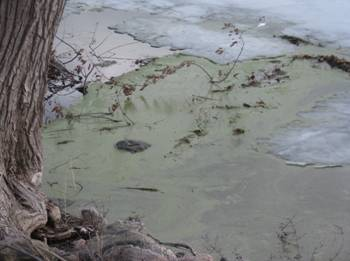We usually think of algae blooms as a summer phenomenon, but some species will occasionally bloom under the ice. Sunlight can still pass through ice allowing photosynthesis. As the days lengthen, the energy of the sunlight hitting the lake increases and blooms become more likely. Diatoms, a major group of algae, are most likely to bloom under ice. The diatoms take advantage of reduced competition from other plants that grow through the summer and of nutrients, in particular silica that continue to wash in from rivers throughout the winter. Silica becomes less available later in the summer as diatoms tie it up and it becomes trapped in the organisms that eat the diatoms or sinks to the bottom of the lake as diatoms die. Diatoms are not blue-green algae, the group that can plague summer waters, and they do not produce toxins.
